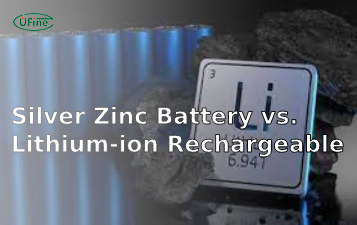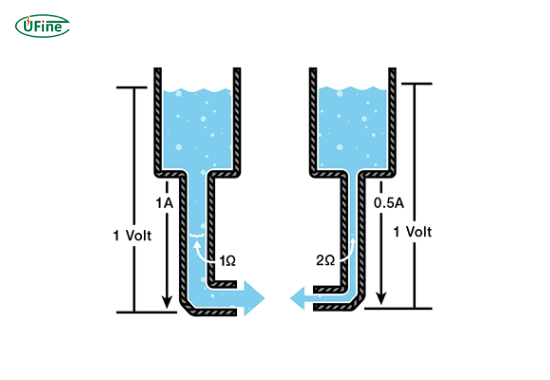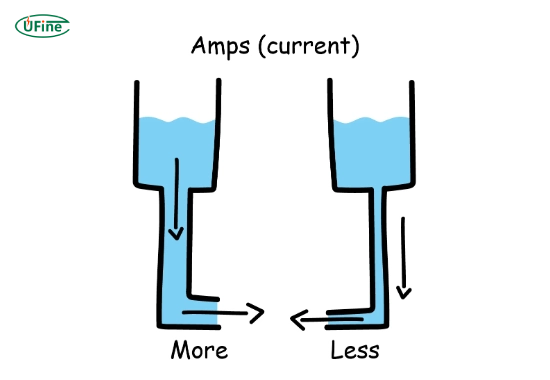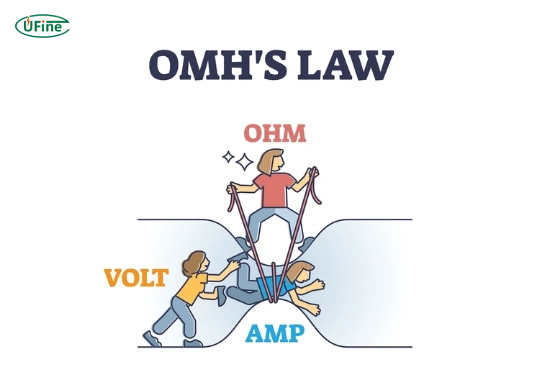
- Part 1. What is the voltage in lithium-ion batteries?
- Part 2. What is Amperage? The Flow Rate Factor
- Part 3. How do voltage and amperage work together?
- Part 4. Difference between voltage and amperage: 5 Critical distinctions
- Part 5. How do voltage and amperage affect the efficiency of an electrical circuit?
- Part 6. How does Ohm's Law relate to voltage and amperage?
- Part 7. Common misconceptions about voltage and amperage
- Part 8. Safety considerations regarding voltage and amperage
- Part 9. Applications of lithium-ion batteries based on voltage and amperage needs
- Part 10. FAQs about voltage and amperage in lithium batteries
Understanding the difference between voltage and amperage is critical when working with lithium-ion batteries. While voltage (V) measures electrical “pressure”, amperage (A) quantifies electron flow rate. This guide explains how these fundamental concepts impact performance in devices from smartphones to electric vehicles.
Part 1. What is the voltage in lithium-ion batteries?
Voltage measures the electric potential difference between two points in an electrical circuit. In lithium-ion batteries, it represents the energy available to push electric charges through a circuit.
What does voltage indicate?
Potential Energy: Think of voltage as the “pressure” in a water pipe. Higher voltage means more potential energy available to work, just like higher water pressure can push more water through a pipe.
Battery Configuration: The nominal voltage of a lithium-ion cell typically ranges from 3.2V to 4.2V, depending on its chemistry and state of charge. For example, a fully charged lithium-ion battery might have a voltage of 4.2V, while it may drop to around 3.0V when discharged.
Why is voltage important?
- Device Compatibility: Different devices operate at specific voltages. Knowing the voltage of a lithium-ion battery ensures it can power a device without causing damage or underperformance.
- Energy Storage Capacity: You can calculate the total energy stored in a battery using the formula:
Energy Wh =Voltage V ×Capacity Ah
This relationship highlights how voltage directly affects the overall energy capacity of the battery.
Part 2. What is Amperage? The Flow Rate Factor
Amperage (current) determines how fast electrons move through a circuit. Think of it as:
Amperage, or current, refers to the flow of electric charge in a circuit and is measured in amperes (A). Amperage indicates how much electricity flows through the battery at any moment.
Understanding amperage
- Current Flow: Amperage represents the rate electric charges pass through a conductor. A higher amperage indicates a greater flow of electricity.
- Battery Discharge Rate: A battery’s discharge rate is often expressed in terms of C-rates, which indicate how quickly a battery can be discharged relative to its capacity. For example, a 1C discharge rate means a battery will discharge its entire capacity in one hour.
Importance of amperage
- Power Delivery: Amperage shows how much power a device can receive at any given moment. Higher amperage allows quicker charging and discharging, crucial for applications like electric vehicles requiring rapid energy transfer.
- Heat Generation: Increased current flow can lead to higher temperatures within the battery due to internal resistance. Technicians must manage this heat generation to prevent damage or reduce lifespan.
Part 3. How do voltage and amperage work together?
Voltage and amperage are interconnected; together, they determine the power output of a battery system. Engineers express the relationship between these two parameters using Ohm’s Law:
Power W =Voltage V ×Current A
Power calculation
- Understanding Power: Power is measured in watts (W) and represents the rate at which energy is used or produced. Manipulating either voltage or amperage can affect the total power output.
- Practical Example: If you have a lithium-ion battery with a voltage of 3.7V and it supplies 2A of current, then the power output would be:
Power=3.7V×2A=7.4W
This calculation shows how both voltage and amperage contribute to overall performance.
Real-World Engineering Application: Tesla Battery Design
Tesla’s battery systems demonstrate optimal voltage-amperage balance:
- Uses high voltage (400V+) to reduce current transmission losses
- Implements parallel modules to increase amperage for rapid acceleration
- Power calculation: 100kW = 400V × 250A
Part 4. Difference between voltage and amperage: 5 Critical distinctions
When comparing voltage and amperage in lithium-ion batteries, several key differences emerge:
- Definition: Voltage refers to the electric potential difference between two points, while amperage refers to the flow of electric charge.
- Measurement Units: We measure voltage in volts (V) and amperage in amperes (A).
- Role in Circuits: Voltage determines how much energy is available, while amperage determines how much current flows through the circuit.
- Impact on Device Performance: A device requires specific voltages to operate correctly; too high or too low can cause malfunction. Amperage impacts energy transfer speed; higher current transfers energy faster but generates more heat.
- Calculation Relationship: We express the power, voltage, and amperage relationship as power = voltage x current.
| Feature | Voltage | Amperage | Real-World Impact |
|---|---|---|---|
| Definition | Electric potential difference | Flow of electric charge | ⚠️ Overvoltage burns circuits |
| Measurement | Volts (V) | Amperes (A) | ✅ V must match device specs |
| Role | Determines energy available | Determines current flow | ⚠️ Overcurrent melts wires |
| Impact | Affects device compatibility | Affects charging/discharging speed | ✅ Higher A enables fast charging |
| Calculation | Energy = Voltage × Capacity | Power = Voltage × Current | ⚡ Determines battery performance |
Part 5. How do voltage and amperage affect the efficiency of an electrical circuit?
The efficiency of an electrical circuit depends significantly on both voltage and amperage.
Voltage Efficiency
- High Voltage Benefits: Higher voltages can reduce current flow for the same power output, leading to lower resistive losses in wires and components. Power loss due to resistance is proportional to I2R (where I is current and R is resistance).
- Lower Voltage Drawbacks: Lower voltages may require higher currents to deliver the same amount of power, which increases heat generation due to resistance losses.
Amperage Efficiency
- Current Flow Management: Effectively managing amperage ensures that devices receive enough power without overheating or damaging components.
- Heat Generation Concerns: High currents lead to increased heat production within circuits, which can reduce efficiency and potentially damage sensitive components over time.
In summary, voltage and amperage must be balanced carefully for optimal circuit efficiency.
According to IEEE report (2024), a 10% voltage increase can improve circuit efficiency by 6-8%, but requires complementary thermal design to manage amperage-induced heat effects.
Part 6. How does Ohm’s Law relate to voltage and amperage?
Ohm’s law is fundamental for understanding the relationship between voltage, current (amperage), and resistance in electrical circuits:
- V=I×R
Where:
- V = voltage (volts)
- I = current (amperes)
- R = resistance (ohms)
Understanding Ohm’s Law
- Direct Relationship: According to Ohm’s Law, if resistance remains constant, an increase in voltage will increase current flow.
- Resistance Impact: Conversely, current will decrease if you increase resistance while keeping voltage constant.
This law helps designers calculate how changes in one parameter affect others within circuits involving lithium-ion batteries.
Part 7. Common misconceptions about voltage and amperage
Understanding voltage and amperage can sometimes lead to misconceptions that hinder the effective use of lithium-ion batteries.
Misconception 1: Higher voltage means more power
- While higher voltage can indicate more potential energy, it only automatically means more power if accompanied by sufficient current flow.
Misconception 2: Amperage alone determines battery life
- Battery life depends on both capacity (in amp-hours) and discharge rates. High amperage draw can lead to faster depletion regardless of capacity.
Misconception 3: All devices require high voltages
- Manufacturers design devices for specific voltages; using the wrong voltage can damage equipment or reduce performance.
Part 8. Safety considerations regarding voltage and amperage
Safety is paramount when dealing with lithium-ion batteries due to their volatile nature under certain conditions.
Overvoltage Risks
- Overcharging can lead to excessive voltages that may cause thermal runaway or even explosions.
- Many modern devices incorporate protection circuits to prevent overvoltage situations.
Overcurrent Risks
- Drawing too much current can lead to overheating and damage.
- Lithium-ion battery systems should always use appropriately rated fuses or circuit breakers.
Part 9. Applications of lithium-ion batteries based on voltage and amperage needs
Lithium-ion batteries are versatile and find applications across various sectors based on their specific voltage and amperage requirements.
Consumer Electronics
Devices like smartphones typically operate around 3.7V with low-to-moderate current draws for efficient operation throughout the day.
Electric Vehicles
EVs often utilize larger battery packs with higher voltages (upwards of 400V) and high-amperage capabilities for rapid acceleration and extended range.
Renewable Energy Storage
In solar energy systems, lithium-ion batteries store energy at varying voltages based on system design while providing adequate current for household use during peak demand times.
Part 10. FAQs about voltage and amperage in lithium batteries
What happens if I use a battery with too high voltage?
Using a battery with higher voltage than your device requires can cause permanent damage due to overvoltage conditions. Always match voltage specifications.
Can I increase the amperage output from my lithium-ion battery?
While you can’t increase a single cell’s amperage, connecting multiple cells in parallel configurations safely boosts total current output.
How do I know if my device requires specific voltage levels?
Check your device’s specifications label or manual. Manufacturers always provide recommended operating voltage ranges for safe operation.
Can using higher amperage damage devices?
Devices only draw the current they need. Using a 5V/2A charger with a 5V/1A device is safe. Voltage must match exactly to prevent damage.
What should I do if my battery overheats?
Immediately disconnect the battery, place it on a non-flammable surface, and allow it to cool. Do not attempt to charge or use it until inspected.
Are there risks with low-voltage operation?
Operating below recommended voltage causes poor performance and may prevent devices from working. Prolonged use can permanently damage battery cells.
Does higher voltage always mean better performance?
Not necessarily. While higher voltage can deliver more power, it must match device specifications. Unmatched voltage can damage components regardless of power output.
How does amperage affect charging speed?
Higher amperage enables faster charging. A 5V/3A charger delivers 50% more power than a 5V/2A charger, significantly reducing charging time.
Related Tags:
More Articles

What is the Difference Between Silver Zinc Battery vs. Lithium-ion Rechargeable?
Compare silver zinc and lithium-ion rechargeable batteries: energy density, cycle life, safety, cost, and uses in drones, medical devices, EVs, and electronics.
What are Watts and Watt Hours in Battery?
Understand watt vs watt-hour in batteries: key differences, how to calculate capacity, and why they matter. Includes free comparison table.
Best 10 Blood Pressure Monitor Battery Review: Finding the Most Reliable
Are you looking for a reliable Blood Pressure Monitor battery? Here is a complete guide with the top 10 best blood pressure monitor batteries.
Bluetooth Headphone Battery Guide: All You Need to Know
Maximize headphone battery life with expert tips! Learn how to charge, check, troubleshoot, and choose the best bluetooth headphone battery in 2025.
LiFePO4 Battery VS. Lithium-ion Polymer Battery: Which One Is Best?
Comprehensive comparison of LiFePO4 vs Lithium Ion Polymer batteries: energy density, safety, lifespan, cost. Find out which battery suits your needs in 2025.






